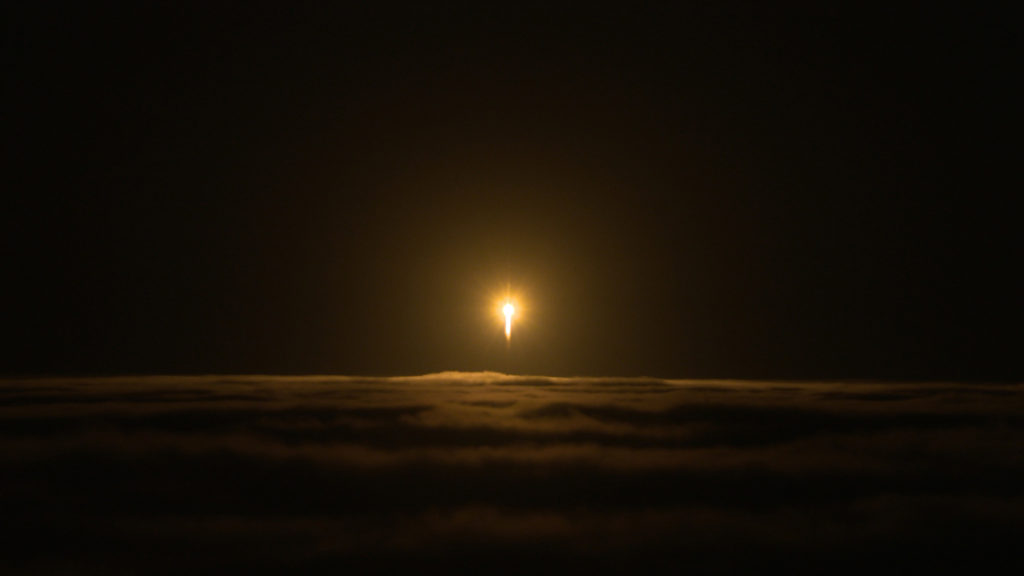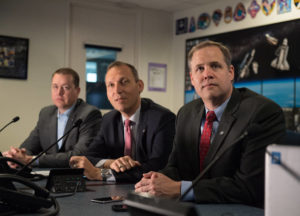NASA’s InSight Spacecraft Now on its Way to Mars

NASA’s Interior Exploration using Seismic Investigations, Geodesy and Heat Transport (InSight) spacecraft is on its way to Mars. InSight launched on a United Launch Alliance (ULA) Atlas V 401 rocket at 4:05 a.m. PDT (7:05 a.m. EDT) this morning, May 5, from Space Launch Complex-3 at Vandenberg Air Force Base in California.
There were no weather constraints at the time of rocket liftoff. Launch occurred at the beginning of the two-hour launch window.

NASA Administrator Jim Bridenstine spoke to the mission team at Vandenberg by phone. “This has been years of work by a whole host of people, for a very long time, including JPL, and of course the launch crew at Vandenberg,” Bridenstine said. “I want to give a special thanks to ULA and congratulate them on 128 total successful launches in in a row, 78 specifically for the Atlas V. I want to thank our international partners, CNES and DLR, for their hard work.”
“It’s been an incredible day,” said Tim Dunn, NASA Launch Director for Insight. “It was a smooth countdown. The mighty Atlas rocket performed very well.”
Following two separate engine burns of the ULA Centaur upper stage, NASA’s InSight spacecraft separated from the Centaur to fly freely for the first time about 1.5 hours after liftoff. The spacecraft now is on its six-month, 300-million-mile voyage to the Red Planet. InSight will land on Mars on Nov. 26, 2018.
InSight is the first interplanetary mission to launch from the West Coast, and will be the first mission to look deep beneath the Martin surface. It will study the planet’s interior by measuring its heat output and listening for marsquakes. InSight will use the seismic waves generated by marsquakes to develop a map of the planet’s deep interior. The resulting insight into Mars’ formation will provide a better understanding of how other rocky planets, including Earth were created.
The InSight lander is equipped with two science instruments that will conduct the first “check-up” of Mars, measuring its “pulse,” or internal activity; its temperature and its “reflexes,” or the way the planet wobbles when it is pulled by the Sun and its moons.
JPL manages InSight for NASA’s Science Mission Directorate. InSight is part of NASA’s Discovery Program, managed by the agency’s Marshall Space Flight Center in Huntsville, Alabama. The InSight spacecraft, including cruise stage and lander, was built and tested by Lockheed Martin Space in Denver. NASA’s Launch Services Program at the agency’s Kennedy Space Center in Florida is responsible for launch service acquisition, integration, analysis, and launch management. United Launch Alliance of Centennial, Colorado, is NASA’s launch service provider.
The science payload comprises two instruments: the Seismic Experiment for Interior Structure (SEIS), provided by the French Space Agency, with the participation of the Institut de Physique du Globe de Paris (IPGP), the Swiss Federal Institute of Technology, the Max Planck Institute for Solar System Research, Imperial College and the Jet Propulsion Laboratory. The second instrument, the Heat Flow and Physical Properties Package (HP3), is provided by the German Space Agency. Also, the Rotation and Interior Structure Experiment (RISE), led by JPL, will use the spacecraft communication system to provide precise measurements of planetary rotation.
Hitching a ride with InSight was NASA’s technology experiment, Mars Cube One (MarCO), a separate mission of its own, also headed to Mars. The two mini-spacecraft, called CubeSats, launched one at a time from dispensers mounted on the aft bulkhead carrier of the Centaur second stage. They were designed and built by NASA’s Jet Propulsion Laboratory in Pasadena, California, and are the first test of CubeSat technology in deep space. Their purpose is to test new communications and navigation capabilities for future missions, and may provide real-time communication relay to cover the entry, descent and landing of InSight on Mars.
“This is a big day. We’re going back to Mars; we did it from the West Coast, which is a first ever,” Bridenstine said. “And of course, the launch of our CubeSats into deep space. This is an extraordinary mission with a whole host of firsts.”
InSight’s lander will spend two years investigating the deep interior of Mars. For more information visit https://www.nasa.gov/mission_pages/insight/overview/index.html.
This concludes today’s coverage of the InSight countdown, launch and ascent into space.

No comments:
Post a Comment